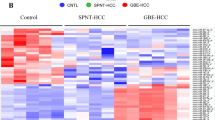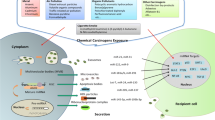Abstract
Bisphenol A (BPA), an widely used environmental chemical, is encircled to human life. However, we generally do not know whether or not it can cause negative health effects. One of the representative epigenetic changes that inhibit gene expression is DNA methylation, which has been very well studied in association with cancer and development. Gene function is changed by DNA methylation; however, its genetic code does not change. Our study hypothesized that a post-transcriptional change in DNA occurs due to exposure to BPA. These changes then cause regulation of microRNA and gene expression. To identify these successional regulations, we conducted microarraybased assays. For validation, also we conducted bisulfite sequencing, quantitative real-time PCR, miRNA inhibitor assay, and Western blotting. We found 1,751 hypo-methylation changed regions, and several micro- RNA had included methylated-regions. miR-22 was also hypomethylated (chr17:1563947-1564031) by BPA-exposure, and expression of miR-22 was up-regulated in an miRNA array and real-time PCR. miR- 22 has been reported to inhibit estrogen signaling by direct targeting of the estrogen receptor alpha mRNA. Taking notice of this point, we analyzed gene expression profiles that included its predicted targets. In the present study, we found the cause of hypomethylation of miR-22 and negative regulation of its apoptosisrelated target gene expression by BPA-exposure. These results suggests that BPA can alter sequential genomic appearances in HepG2 cells, a potentially affection of BPA toxicity. Also, the results of our study support that toxicology study need to integrated analysis of array-based assays for help in understanding of the molecular action of environmental toxicants.
Similar content being viewed by others

References
Nuwaysir, E.F., Bittner, M., Trent, J., Barrett, J.C. & Afshari, C.A. Microarrays and toxicology: the advent of toxicogenomics. Mol. Carcinog. 24, 153–159 (1999).
Donald, S. et al. Hepatobiliary damage and changes in hepatic gene expression caused by the antitumor drug ecteinascidin-743 (ET-743) in the female rat. Cancer Res. 62, 4256–4262 (2002).
Heinloth, A.N. et al. Gene expression profiling of rat livers reveals indicators of potential adverse effects. Toxicol. Sci. 80, 193–202 (2004).
Kim, S.J. et al. HazChem human array V3: Classification of environmental toxicants through gene expression pattern for risk assessment. BioChip J. 3, 293–298 (2009).
Okada, H. et al. Direct evidence revealing structural elements essential for the high binding ability of bisphenol A to human estrogen-related receptor-γ. Environ. Health Perspect. 116, 32–38 (2008).
Mikol, Y.B., Hoover, K.L., Creasia, D. & Poirier, L.A. Hepatocarcinogenesis in rats fed methyl-deficient, amino acid-defined diets. Carcinogenesis 4, 1619–1629 (1983).
Yu, M.C., Yuan, J.M. & Lu, S.C. Alcohol, cofactors and the genetics of hepatocellular carcinoma. J. Gastroenterol. Hepatol. 23, S92–S97 (2008).
Bartel, D.P. MicroRNAs: genomics, biogenesis, mechanism, and function. Cell 116, 281–297 (2004).
Chen, C.-Z., Li, L., Lodish, H.F. & Bartel, D.P. Micro-RNAs modulate hematopoietic lineage differentiation. Science 303, 83–86 (2004).
Garzon, R., Fabbri, M., Cimmino, A., Calin, G.A. & Croce, C.M. MicroRNA expression and function in cancer. Trends Mol. Med. 12, 580–587 (2006).
Dolinoy, D.C., Huang, D. & Jirtle, R.L. Maternal nutrient supplementation counteracts bisphenol A-induced DNA hypomethylation in early development. Proc. Natl. Acad. Sci. 104, 13056–13061 (2007).
Pandey, D.P. & Picard, D. miR-22 inhibits estrogen signaling by directly targeting the estrogen receptor α mRNA. Mol. Cell. Biol. 29, 3783–3790 (2009).
Chou, F., Chung, H., Liu, H., Chi, C. & Lui, W. Suitability of boron carriers for BNCT: Accumulation of boron in malignant and normal liver cells after treatment with BPA, BSH and BA. Appl. Radiat. Isot. 67, S105–S108 (2009).
Hanet, N. et al. Effects of endocrine disruptors on genes associated with 17β-estradiol metabolism and excretion. Steroids 73, 1242–1251 (2008).
Zilberman, D., Gehring, M., Tran, R.K., Ballinger, T. & Henikoff, S. Genome-wide analysis of Arabidopsis thaliana DNA methylation uncovers an interdependence between methylation and transcription. Nat. Genet. 39, 61–69 (2006).
O’Connor, J.C. & Chapin, R.E. Critical evaluation of observed adverse effects of endocrine active substances on reproduction and development, the immune system, and the nervous system. Pure. Appl. Chem. 75, 2099–2123 (2003).
Richter, C.A., Taylor, J.A., Ruhlen, R.L., Welshons, W.V. & vom Saal, F.S. Estradiol and Bisphenol a stimulate androgen receptor and estrogen receptor gene expression in fetal mouse prostate mesenchyme cells. Environmental Health Perspectives, 902–908 (2007).
Esteller, M. Epigenetics in cancer. N. Engl. J. Med. 358, 1148–1159 (2008).
Merlo, A. et al. 5’ CpG island methylation is associated with transcriptional silencing of the tumour suppressor p16/CDKN2/MTS1 in human cancers. Nat. Med. 1, 686–692 (1995).
Gregory, R.I., Chendrimada, T.P., Cooch, N. & Shiekhattar, R. Human RISC couples microRNA biogenesis and posttranscriptional gene silencing. Cell 123, 631–640 (2005).
Lujambio, A. et al. Genetic unmasking of an epigenetically silenced microRNA in human cancer cells. Cancer Res. 67, 1424–1429 (2007).
Gabai, V.L. et al. Hsp72-mediated suppression of c- Jun N-terminal kinase is implicated in development of tolerance to caspase-independent cell death. Mol. Cell. Biol. 20, 6826–6836 (2000).
Chen, C.-J. et al. Identification of a key pathway required for the sterile inflammatory response triggered by dying cells. Nat. Med. 13, 851–856 (2007).
Kol, S. et al. The rat intraovarian interleukin (IL)-1 system: cellular localization, cyclic variation and hormonal regulation of IL-1β and of the type I and type II IL-1 receptors. Mol. Cell. Endocrinol. 149, 115–128 (1999).
Soung, Y.H. et al. Inactivating mutations of CASPASE- 7 gene in human cancers. Oncogene 22, 8048–8052 (2003).
Diener, K. et al. Activation of the c-Jun N-terminal kinase pathway by a novel protein kinase related to human germinal center kinase. Proc. Natl. Acad. Sci. 94, 9687–9692 (1997).
Revankar, C.M., Vines, C.M., Cimino, D.F. & Prossnitz, E.R. Arrestins block G protein-coupled receptor- mediated apoptosis. J. Biol. Chem. 279, 24578–24584 (2004).
Salehi, A.H., Xanthoudakis, S. & Barker, P.A. NRAGE, a p75 neurotrophin receptor-interacting protein, induces caspase activation and cell death through a JNK-dependent mitochondrial pathway. J. Biol. Chem. 277, 48043–48050 (2002).
Adams, B.D., Furneaux, H. & White, B.A. The microribonucleic acid (miRNA) miR-206 targets the human estrogen receptor-α (ERα) and represses ERα messenger RNA and protein expression in breast cancer cell lines. Mol. Endocrinol. 21, 1132–1147 (2007).
Zhao, J.-J. et al. MicroRNA-221/222 negatively regulates estrogen receptor α and is associated with tamoxifen resistance in breast cancer. J. Biol. Chem. 283, 31079–31086 (2008).
Park, K. & Kwak, I.-S. Molecular effects of endo-crine-disrupting chemicals on the Chironomus riparius estrogen-related receptor gene. Chemosphere 79, 934–941 (2010).
Kim, S.J. et al. Toxicogenomic Effect of Liver-toxic Environmental Chemicals in Human Hepatoma Cell Line. Mol. Cell. Toxicol. 5, 310–316 (2009)
Chen, C. et al. Real-time quantification of microRNAs by stem-loop RT-PCR. Nucleic Acids Res. 33, e179–e179 (2005).
Bradford, M.M. A rapid and sensitive method for the quantitation of microgram quantities of protein utilizing the principle of protein-dye binding. Anal. Biochem. 72, 248–254 (1976).
Author information
Authors and Affiliations
Corresponding author
Rights and permissions
About this article
Cite this article
Kim, S.J., Yu, SY., Yoon, HJ. et al. Epigenetic Regulation of miR-22 in a BPA-exposed Human Hepatoma Cell. BioChip J 9, 76–84 (2015). https://doi.org/10.1007/s13206-014-9110-2
Received:
Accepted:
Published:
Issue Date:
DOI: https://doi.org/10.1007/s13206-014-9110-2



